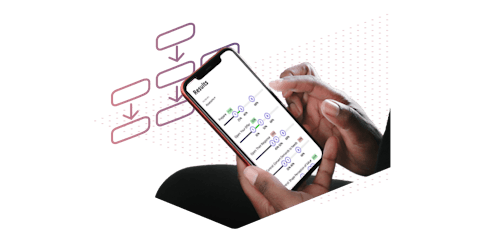Micro-moment Sales and Marketing

Mobile devices and 24/7 access to information have certainly changed the way business is conducted. Case in point: More than half of all searches on www.Richardson Sales Performance.com are done on mobile devices, the numbers rising to 52% from 19% in less than a year.
In a B2C world, such a dramatic and rapid shift would make more sense, driven by on-the-go searches by consumers looking for restaurants or best product prices. But for a B2B company like Richardson Sales Performance? It’s hard to imagine someone waiting in line for a latte to suddenly tap her iPhone and say, “Siri, I need to implement a sales training transformation for my 5,000 global sales reps — which providers should I call?”
Google has a brilliant name for what’s happening in B2B and B2C marketing: micro-moments. Basically, buyers are having instantaneous impulses when they want information, when they want to watch something, when they want a demo, or when they want to learn more about something. Wherever they are, whatever they are doing, and whatever devices they have access to, they can satisfy these sudden needs and desires in real time. Buyers waiting until they get home or to the office to use a stationary computer for searches is so yesterday.
Where does that leave marketing?
The digital environment has shifted the playing field in favour of buyers, and now, marketing and sales are forced to catch up to their demands. Savvy marketing organisations are starting to transition to the micro-moment approach. They realise the importance of including in their overall strategy such elements as content-based marketing, social marketing, search engine optimisation (SEO), and search engine marketing (SEM). Only through these elements can marketers ever hope to satisfy a buyer’s micro-moment, making sure that their brand, value, and products show up when there’s an instantaneous search.
Additionally, marketing groups need to continue with outbound, push campaigns, while also thinking about and identifying any gaps in content to capture these micro-moment searches. This means leveraging analytics and spending a significant amount of time looking at both short-tail and long-tail keywords, reviewing competitive digital strategies, and monitoring website bounce and visitor trails — just to name a few key aspects. Marketing today has to be able to understand the buyer’s complete journey and anticipate potential moves, along with the devices that will be used.
Beyond readiness to meet the buyer�’s reactive mode, marketing also needs to develop strategies to create what I call a supplier-induced micro-moment. These strategies leverage such digital tools as re-marketing and both persona and content-based data capture tools that push customised content and recommendations to website visitors based on searches and visited web pages.
BrightInfo is one such tool that does an excellent job in helping to improve conversion rates and leads. It works by tracking a website visitor’s movement, and then, based on that movement, serves up appropriate content. In effect, it creates a flipped micro-moment.
In this brave new digital world, there’s little time to waste. Messaging, positioning, and differentiation are becoming ever more critical for marketers as every competitor is trying to make sense of this trend, which also adds more noise to the marketplace and, to an extent, commoditises each digital tool and technique.
What does this mean for sales?
Do micro-moments mean the end of sales professionals? Quite the contrary. They are more important than ever before, although their role continues to evolve, change, and grow. During the micro-moment process, buyers may be researching products and company information. They will download content, articles, and brochures. Sales professionals need to be able to follow up, nurture, challenge, and provide insights to buyers to help influence and differentiate themselves and their companies.
Selling with insights and possessing the skills to have extra-ordinary dialogues with well-informed buyers will become ever more critical to sales professionals’ successes. They also will need to prepare for and execute on buyers’ micro-moments, joining the conversation by participating in social media activities, such as tweeting or posting updates on LinkedIn. They need to focus on building a personal brand by blogging and sharing marketing content. I recommend a tool like PeopleLinx for an automated system that enables social selling.
Finally, sales professionals need to be contributing consistent value in group discussions and when talking directly to prospects — not just pitching products or delivering data points. By deploying social-selling and value-added tactics, they are better able to gain quick access to buyers when a micro-moment occurs.

Richardson Accelerate™ Sales Performance Platform
Accelerate provides a digital learning experience that uses assessments, video, gamification, and bite-sized modules to build sales competencies.
Learn MoreMuch work and potential ahead
For organisations to be successful in this new reality, marketing and sales groups must be completely aligned and working in the same direction. Marketing needs to map out the buyers’ journeys and leverage analytics, while sales professionals need the skills to have deep dialogues that provide value. The successful sales professionals will be those who become stronger experts in their fields and products so that they can provide insights and value to clients and prospects.
While the digital environment has initially shifted in favour of buyers, micro-moment sales and marketing tools are helping to restore balance in the playing field.

eBook: How the Marketing Team Should Work With Sales
DownloadGet industry insights and stay up to date, subscribe to our newsletter.
Joining our community gives you access to weekly thought leadership to help guide your planning for a training initiative, inform your sales strategy, and most importantly, improve your team's performance.






